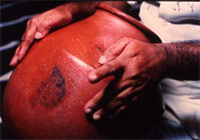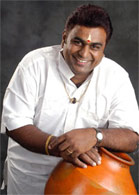GHATAM
Introduction
GHATAM replicates or conveys the meaning of the pot in Sanskrit. It is an ancient percussive instrument and ancient like other musical instruments mridangam, veena, etc. Sage Valmiki in his Ramayana has described about the sound emanating from GHATAM (Sundara Kandam, Chapter 10, and Sloka 46).Even the work called "Krishna Ganam", there is an important reference about "GHATAM" there is a description of a cowherd playing on a pot as an accompaniment to Lord Krishna's Flute. GHATAM has found its place in ancient books on musical instruments.
Ghatam is known as Noot in Kashmir and Mudki in Rajasthan, it was a folk instrument in olden days. In south India, Ghatam is a highly sophisticated instrument raised to concerts status. Apart from traditional concert platforms, GHATAM Instrument in India is also gaining prominent status in Rock music, Jazz, Jugal bandhis, Fusion, Ensembles and unique programmes.

The Ghatam from south India is bulbous earthenware jug that is open at the top and has a narrow neck. It can be positioned on the lap or on a tabla ring and is played with the fingers of both hands. The belly, neck and upper rim produce different tone colours. A characteristic bass tone that can produce the results from beating the opening with the palm of one's hand.
The Ghatam was already mentioned in the great Indian epic, the Ramayana. In Punjab it is called Bada and in Kashmir as Ghara; - in southern India it is known as Ghatam. The Karnatic music often uses the Ghatam together with the Mridangam in the form of Sawal-Jawab (question-answer play). It usually consists of a mixture of clay, iron dust or other metallic components. For playing it, the finger technique of the tabla is usually used, but the Ghatam can also be used for improvising.
Popular Musicians

How to play a Ghatam
In North India, the instrument is placed on a small round block with the mouth facing upwards and played on the sides by right hand on the mouth by left hand. Rings and bangles are also used to create sound. But in South India, it is placed on the lap, its mouth facing the stomach, played with gush of air with the help of belly. It is played with fingers, wrists and even nails. Its position is changed while playing. It is the only instrument whose position is changed while playing. Sometimes to delight the audience, the instrument is thrown up and caught suitable in rhythm, mainly during laya vinyasas.Conventionally Ghatam is not played in the upright position kept on a ring or stand. It is kept on the lap and kept in an angular position where the mouth of the ghatam facing the chest and neck of the performer. The base is usually produced occasionally with the palm covering the open mouth of the ghatam. But this sound is too loud and high bass. The frequently used base or GAMAKA /GUMUKI is by the combination of two actions. One is playing on the neck of the ghatam with the wrist (strongly) keeping the fingers folded for better or good power and accent. The second action is simultaneously done is by moving the ghatam outwards (through the above said stroke) from the stomach or tummy which partially keeps the mouth of the ghatam covered normally. The air column inside ghatam is forced to go out in the movement and with the stroke is produces a beautiful base sound.
Where to learn to play a Ghatam
VAIDYANATHAN SURESHB5, PRINCE TOWER,
4/13 ,MARVADI THOTTAM
MYLAPORE
CHENNAI - 600004.
Phone : 91 44 2461 4539
Cell : 91 94442 08033
Email : [email protected]
[email protected]
Sukkanya Ramgopal
Flat. No. 306, Divya Land Mark Apartments
No.9, M S R Main Road
Yeshwantpur
Bangalore
India
Pin: 560022
Telephone: 0091 80 23607235
Mobile: 09845524280
E-mail: [email protected]
Where to buy a Ghatam
Indian Musical Instruments2-B Netaji Subhash Marg,
Main Road,
Darya Ganj,
New Delhi 110002
India.
Helpline Number: 91-11- 43513848, 91-11- 23270666,
91-11- 23273687 Fax Number: 91 - 11 - 43582673
Email: [email protected]
Email: [email protected]
Ghatam Dr. S. Karthick
New No.6,Old No.31,
"Raghas - G3 Postal colony 2nd street,
West mambalam, Chennai - 600033.
Tamilnadu,India
Mobile: 91 - 944429960
Phone: 91 - 44- 24746598,43512921
E-Mail: [email protected]


